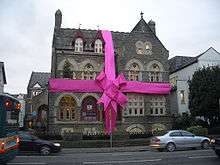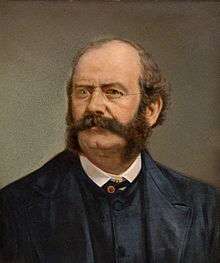Park House, Cardiff
.jpg)
Park House, formerly known as McConnochie House, is a town house in Cardiff. It was built for John McConnochie, Chief Engineer to the Bute Docks, by the Gothic revivalist architect William Burges. It is a Grade I listed building. "By its powerful early French Gothic style, its steep roofs and boldly textured walls (the house) revolutionized Cardiff's domestic architecture."[1]
Commissioned by McConnochie in 1871, the house was completed externally by 1874, although decoration of the interior continued, somewhat slowly, until McConnochie's Cardiff mayoral year of 1880. The house was much admired at the time of its construction, being referenced by Viollet-le-Duc and its plans displayed at the Royal Academy. Today, the house is of particular interest for three reasons; as the precursor of Burges' own house in Kensington, as evidence of one of the few architectural errors Burges made in his career and as a template for an architectural style which had a significant influence on late Victorian/Early Edwardian Cardiff.
The style of the house is Burges' signature Early French Gothic,[2] with triangle and rectangle to the fore, although it is without the conical tower felt appropriate for Burges' own home and for Castell Coch. The external frontage comprises four gables, the windows of the last gable concealing the major error of the interior, the fact that the entrance confronts the visitor with the underside of a colossal staircase.[1] It is hard to understand how Burges could have made such a mistake. It was not repeated at The Tower House, which is an almost, reversed, replica, with added conical tower.[3] The style of the house was widely imitated, in Cardiff and beyond and this can be evidenced by walking tours of any of Cardiff's inner suburbs, where faint and not so faint traces of Burges' influence can be seen. Cadw described Park House as "perhaps the most important 19th century house in Wales".[4]
Burges used various building stones for Park House, Pennant Sandstone for the walls, Bath stones around the windows, entrance porch and plinths, while the pillars are pink Peterhead granite from Aberdeenshire.[5]

The house is now a restaurant. To publicise its opening to the public in 2012, the owner wrapped the building with a giant red ribbon. As this had been done without listed building consent, Cardiff council demanded its removal.[6]
References
- 1 2 Newman, p. 219.
- ↑ Newman, pp. 218-219.
- ↑ Mordaunt Crook, p. 306.
- ↑ The most important 19th century house in Wales
- ↑ Cardiff city and bay circular walk
- ↑ "Giant ribbon stunt at Park House restaurant 'illegal'". BBC News Online. 7 June 2012.
Sources
- Crook, J. Mordaunt (2013). William Burges and the High Victorian Dream. Frances Lincoln. ISBN 978-0-7112-3349-2.
- Newman, John (2001). Glamorgan. The Buildings of Wales. Penguin. ISBN 0-14-071056-6.
External links
![]() Media related to Park House, Cardiff at Wikimedia Commons
Media related to Park House, Cardiff at Wikimedia Commons
- Through the Keyhole at Park House (Cardiff Council)
- Park House Members Club and Restaurant
- Park House Weddings
Coordinates: 51°29′06″N 3°10′32″W / 51.4849°N 3.1756°W
